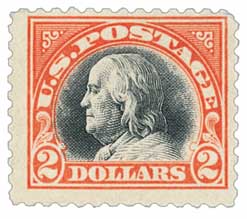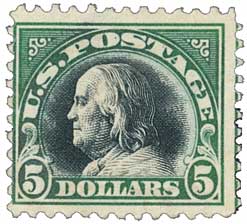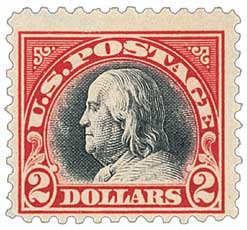
# 547 - 1920 $2 Franklin, carmine black
1920 $2 Franklin
Flat Plate Printing
Quantity Issued: 743,680
Printed by: Bureau of Engraving and Printing
Printing Method: Flat plate
Perforation: 11 gauge
Color: Carmine and black
Once thought to be an error stamp, #547 has an interesting background. It played a prominent part in history immediately following World War I.
to Post-World War I Europe
Once Thought To Be a Color Error
U.S. #523 Color Error

U.S. #523, the 1918 $2 orange-red Franklin error stamp, was first used on August 1918. But it would be two years before the error was discovered.
The ravages of World War I caused a famine in Russia and threw the rest of Europe into disarray. In the U.S., relief agencies as well as private individuals mailed food, clothing, machine parts and valuable Liberty Bonds to Europe. These packages were expensive to send by ship across the Atlantic and required high-value stamps. For this purpose new $2 and $5 stamps were issued in August 1918.

Both stamps featured a similar design of Benjamin Franklin with a difference in denomination and color. The $2 stamp had an orange-red frame, while the $5 stamp had a green frame. Many of these stamps were bought and used on packaged to Europe. Then two years later, on November 1, 1920, the $2 stamp began appearing in a different color – carmine. Stamp collectors believed they had found a new error! When philatelic writers inquired about the new color, the Bureau of Engraving and Printing informed them “this stamp has always been this color.”

The Bureau investigated and discovered the earlier color had been the error. All communications between the Post Office Department and the Bureau of Engraving and Printing listed the newer stamp’s colors as carmine and black. No longer considered an error, the newer “correct” version of the stamp was given the Scott number 547.
Because the discovery was made more than two years after U.S. #523 had been issued, collectors who’d overlooked it scrambled to get the stamp. Many, however, had served their function and been discarded.
| Both stamps were issued in limited numbers by today’s standards, but click the images above to choose from a variety of conditions to add one to your collection. |
1920 $2 Franklin
Flat Plate Printing
Quantity Issued: 743,680
Printed by: Bureau of Engraving and Printing
Printing Method: Flat plate
Perforation: 11 gauge
Color: Carmine and black
Once thought to be an error stamp, #547 has an interesting background. It played a prominent part in history immediately following World War I.
to Post-World War I Europe
Once Thought To Be a Color Error
U.S. #523 Color Error

U.S. #523, the 1918 $2 orange-red Franklin error stamp, was first used on August 1918. But it would be two years before the error was discovered.
The ravages of World War I caused a famine in Russia and threw the rest of Europe into disarray. In the U.S., relief agencies as well as private individuals mailed food, clothing, machine parts and valuable Liberty Bonds to Europe. These packages were expensive to send by ship across the Atlantic and required high-value stamps. For this purpose new $2 and $5 stamps were issued in August 1918.

Both stamps featured a similar design of Benjamin Franklin with a difference in denomination and color. The $2 stamp had an orange-red frame, while the $5 stamp had a green frame. Many of these stamps were bought and used on packaged to Europe. Then two years later, on November 1, 1920, the $2 stamp began appearing in a different color – carmine. Stamp collectors believed they had found a new error! When philatelic writers inquired about the new color, the Bureau of Engraving and Printing informed them “this stamp has always been this color.”

The Bureau investigated and discovered the earlier color had been the error. All communications between the Post Office Department and the Bureau of Engraving and Printing listed the newer stamp’s colors as carmine and black. No longer considered an error, the newer “correct” version of the stamp was given the Scott number 547.
Because the discovery was made more than two years after U.S. #523 had been issued, collectors who’d overlooked it scrambled to get the stamp. Many, however, had served their function and been discarded.
| Both stamps were issued in limited numbers by today’s standards, but click the images above to choose from a variety of conditions to add one to your collection. |





















